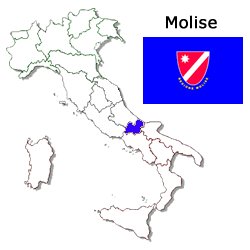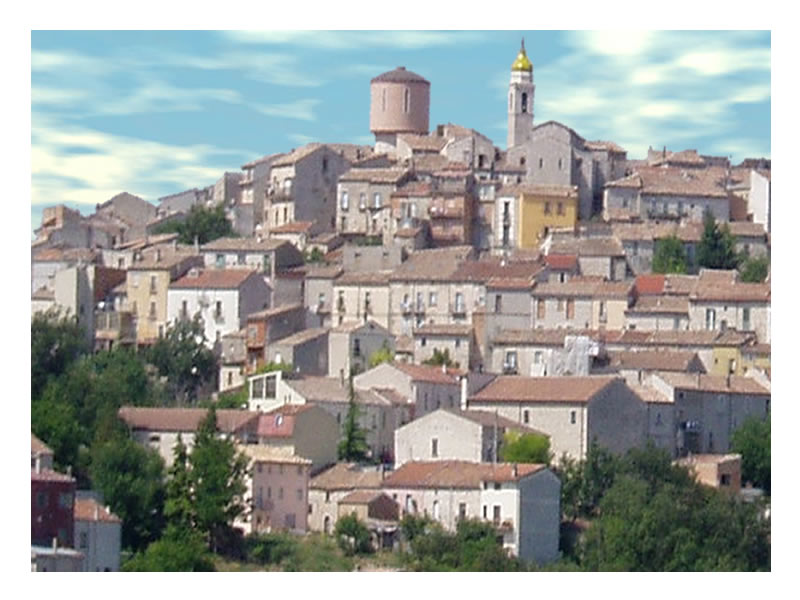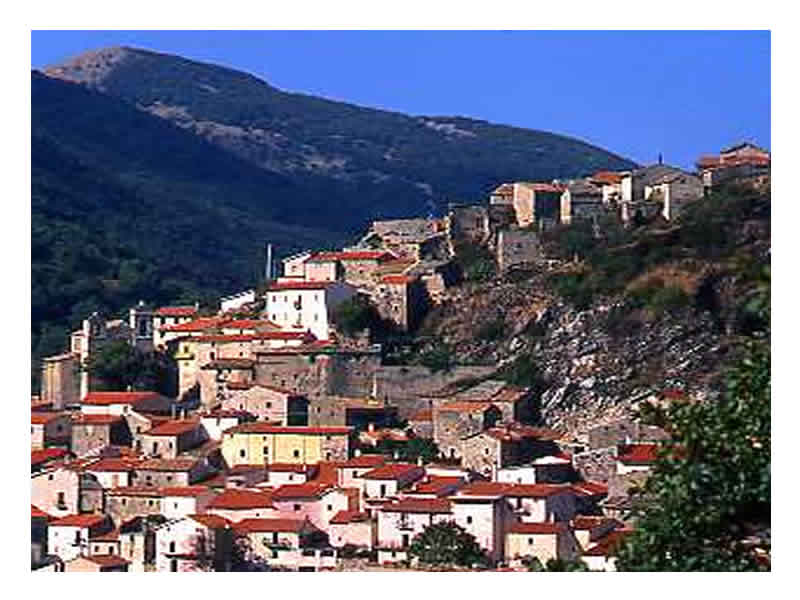|
 Information on Molise - Italy Information on Molise - Italy
 Campobasso Campobasso  Isernia Isernia
For most Italians, Molise and Abruzzo are notably linked. This small, unyielding region facing the Adriatic only gained independence from Abruzzo in 1963. Molise is unique in that it is somewhat insulated from the changes that have overtaken the rest of the Italy.
Bread, wine, and oil are staples of Molise cuisine. In fact, olive oil is the region's primary industry. Chili pepper is used liberally and often here, as it is in most other southern Italian regions. Very little meat is eaten in Molise; when it is, it's likely to be lamb or pork.
The legacy of the Molise people is something called la transumanza, a huge human migration occurring at a particular time each year. The migration dates back to prehistoric time when shepards migrated with their flocks to better grazing land. Many Molise dishes are simple and reflect the need to be cooked quickly, as they would have been by people on the move.
 We welcome inquiries for available accommodations for the region of Molise and surrounding areas. Contact us for listing requirements. (Hotels - Motels - Villas - Bed & Breakfast - Condo Rentals, Agriturismo & all related accommodations) We welcome inquiries for available accommodations for the region of Molise and surrounding areas. Contact us for listing requirements. (Hotels - Motels - Villas - Bed & Breakfast - Condo Rentals, Agriturismo & all related accommodations)
|
| |
Campobasso
 Campobasso is the region capital city since 1806, when Giuseppe Napoleone established the Contado di Molise. Once world-famous for its cutlery craftsmanship, is divided into an old town, with the majestic Castello Monforte and its six towers, and an archaeological museum of the Samnite people hosted in a former medieval building. Campobasso is the region capital city since 1806, when Giuseppe Napoleone established the Contado di Molise. Once world-famous for its cutlery craftsmanship, is divided into an old town, with the majestic Castello Monforte and its six towers, and an archaeological museum of the Samnite people hosted in a former medieval building.
The medieval borough contains three active medieval churches: Santa Maria della Croce, San Leonardo, and Santa Maria del Monte, as well as an archaeological Museum of the Samnite people, located in an ancient palace. Many of the homes within the old section are being restored, although the exteriors must remain the same, and the area is increasingly becoming an exclusive section to live in. The "new" town located outside of the walls in the lower fertile plain dates back to the 16th century (the church of Sant'Antonio Abate, circa 1572, was built just outside the medieval walls). In the gardens of the city there are many rare plant species. The most interesting folk tradition is the Holy Week representation called "Misteri".
 What to taste: What to taste:
• In a nation of peasants and shepherds, which has been for millennia the Molise, eating habits were stratified in places of daily work, in what seasonally the camps offered and in the availability of meat from the small farms.
• The typical food of Campobasso is based on authentic ingredients such as zucchini, caciocavallo (cheese), sausages. Among the pasta dishes are soups made of vegetables grown in this area as lentils, pearl barley, broad beans and beans.
•
But the dish that characterizes most of this city is definitely the caponata made with a biscuit wheat (Tarallo) wet with water and vinegar and flavoured with tomatoes, celery, peppers, anchovies, black olives and boiled eggs.
• Then we have the crioli with nuts, dried cod cooked with chopped nuts; tacozze and fagioli, homemade pasta sauce with beans and pork rind.
• Be reported across the province are also the amazing sausages and meat: capocollo seasoned pork, ciccioli, ham, pork sausage, brawn, torcinelli (roulade) and ventresca.
• The diversity of the area is ideal condition for the presence of many varieties of mushrooms such as boletus, field mushrooms and gallinacci, in addition to the truffle.
• And again, the cheeses, as caciocavallo, burrino, mozzarella and pecorin.
• Among the most famous wines are Biferno (white, red and rosé) and Moscato.
 Cities & Towns: Cities & Towns:
 Coming soon Coming soon
 What to do: What to do:
• The mountains of Molise offer a unique scene in every season, thanks to nature.
• The lush forests of the Matese mountains are a natural habitat of extraordinary value for wildlife such as wolves and birds of prey. The territory is the ideal destination for lovers of mountaineering activities, excursions and caving, as it is rich in natural karst caves where we can admire beautiful natural phenomena, stalactites, stalagmites, pots, traps and various concretions.
• Among the most famous places of the province there is then Campitello Matese, which belongs to the Municipality of S. Massimo, attractive foreground for ski enthusiasts, thanks to the superb pistes and lifts of excellent quality.
• In the province of Campobasso there are also two natural reserves, which are ideal for excursions to discovering the flora and fauna: the Oasis LIPU in Casacalenda and the Oasi WWF Guardiaregia-Campochiaro.
• Characteristic of the region include the sheep tracks, grassy paths that shepherds and flocks from summer pastures travelled to the plains of Puglia.
• For lovers of the sea, the province has 38 kilometres of coastline on the Adriatic, with resorts that are equipped to be set as gems in the beautiful landscape: Petacciato, Termoli, Montenero di Bisaccia and Campomarino.These locations may be meeting all the needs of tourists, by providing high quality service and accommodations such as hotels, campsites, restaurants and equipped bathing establishments. Also offer links with the islands Tremiti, ideal for diving enthusiasts.
 Places to visit: Churches, Museums, Ruins, Piazzas, Fountains, Places to visit: Churches, Museums, Ruins, Piazzas, Fountains,
• The Monforte Castle, located on the top of Sant'Antonio Mountain, dates back to the 13th century
• Church of Santa Maria del Monte (11th century), located on the top of the Sant'Antonio Mountain in front of the Monforte Castle. Its original name was "Santa Maria de supra" or "de Campobasso". In 1525 it took the name of Santa Maria Maggiore until 1829, when the Cathedral was called with the same name. The frescoes inside are by the local painter Amedeo Trivisonno (1944-1945). The bell tower was added in 1970 and it is 26 mt high.
• Church of San Giorgio (10th century), which lost its original aspect due to the earthquakes and following reconstruction.
• Church of San Bartolomeo (11th century), today no more a place of worship.
• Church of San Leonardo, dating back to the 13th century, but modified during the 14th century and restored after the earthquake of 1456; the entrance stairways were substituted in the early 20th century.
• The Cathedral (14th century) dedicated to Santa Maria Maggiore, built by Andrea di Capua in 1504; destroyed by the earthquake of 1805, was rebuilt between 1815 and 1829.
• Church of S. Maria della Croce (15th century) located in contrada Chiancone, it was destroyed by earthquakes, once in 1348 and a second time in 1805; the present architecture is the result of the reconstruction of 1930-1936. The dome, unique in Campobasso, is probably the most beautiful in the whole region of Molise.
•Church of Sant'Antonio Abate built in 1572, it became the richest in the city; in the facade there is a late-Renaissance portal that dates back to 1572.
 Events: Events:
• (Add an known event by sending a email here).
 Tours avaiable in the region: Tours avaiable in the region:
 Accomodations in close proximity: Hotels, Restorts, Holiday Houses, Condo Rentals, Farm Holidays (Agritourismo), Accomodations in close proximity: Hotels, Restorts, Holiday Houses, Condo Rentals, Farm Holidays (Agritourismo),
 Flights - Car Rentals - Cruises: Flights - Car Rentals - Cruises:
 Restaurants in close proximity: Restaurants in close proximity:
• (Add a restaurant review in the italian blog area of our website).
|
|
| |
Isernia
 Isernia is situated on a rocky crest rising from 350 mt to 475 between the Carpino and the Sorsi rivers, Isernia still reflects with its road plan the ancient structure of the Roman town, with a central wide street and side streets on both sides. Isernia is situated on a rocky crest rising from 350 mt to 475 between the Carpino and the Sorsi rivers, Isernia still reflects with its road plan the ancient structure of the Roman town, with a central wide street and side streets on both sides.
It is now the Capital city of the province of Isernia, and a flourishing center of pasta makers, stone work, embroidery crafts. The name of the town come from the italic root "aiser" meaning "god".
Aesernia was the capital of the Samnites, and in 263 Rome established a colony here, a key communication center between Southern Italy and the inner Appennine Regions. During the social wars against Rome, the Italic League established here their capital after abandoning Corfinio. It was a Roman "municipium" and its inhabitants enjoyed Roman citizenship. In 800 it was destroyed by the Saracens, then sacked in 1199 by Marcovaldo, Count of Molise, then set on fire in 1223 by the soldiers of Frederick II. In 1519 it was freed from the feudal servitude by king Charles V and became a free city. Massive destruction was caused by earthquakes in 847, 1349, 1456 and 1805. During the second world war, in September 1943 air bombings destroyed over half city, killing one third of the population.
 What to taste: What to taste:
• The province of Isernia is a real mine for the extraction of precious white and black truffles. Beyond that, the gastronomy of Molise has pastoral and peasant origins that are found in the genuineness of ingredients and simplicity of preparation.
• The products are typical earthbound as grain, vegetables, pork and lamb.
• The typical dishes of this region are crjoli (pasta alla chitarra), the cavatelli (potato and flour dumplings) with tomato and pork, the laganelle with beans (a sort of lasagna). The second dish of Isernia is roasted turcinelli, a recipe based on very elaborate lamb interiors. Be pointed out the delicious meats like sausages and cheeses as well sopressata cheese, mozzarella and scamorze, stracciata, burrino and pecorino.
• And yet, the olive oil, particularly of Venafro, considered to be very popular; the “ovicoltura” is widely practiced in the province and ensures production of high quality.
• Among the desserts there are ingredients such as dried fruit, honey, pine nuts: the typical desserts are the calzoni stuffed with chocolate, chickpeas, cinnamon, pine nuts and honey, i pepatelli (with almonds), the caggiunitti (donuts filled with chestnuts).
• Among the wines we Biferno (white, red and rosé) and Pentro (white, red and rosé), which have earned the label of DOC wines. Then there also typical liqueurs like poncho (flavoured with orange and mandarin) and limoncello.
 Cities & Towns: Cities & Towns:
 Coming soon Coming soon
 What to do: What to do:
• The province of Isernia is one of two provinces in the region of Molise. It is bounded by the Abruzzo on the north (Provinces of L’Aquila and Chieti), by the Province of Campobasso on the east, by the Campania on the south (Province of Caserta), and by the Lazio (Province of Frosinone). It comprises 52 communes, among which only two go over the 10.000 inhabitants.
• The territory is mostly mountainous and has a huge forest and nature environment. In fact, in the Province numerous protected areas arise, as the field of Mainarde the National Park of Abruzzo, Lazio and Molise, the two Oriented Natural Reserves of Collemeluccio and Montedimezzo (included in the UNESCO-MAB Man and Biosphere program for the study of the relationship between man and environment, thanks to the high content of biodiversity), the Garden of the Apennine Flora of Capracotta, the Natural Oasis of WWF “Le Mortine” of Venafro and the Oriented Natural Reserve of Pesche.
• Towards the southwest, the mountains give way to hills and plains (plain of Venafro). Peculiarities of the area is the presence of Tratturi, broad grassy path, stony and gravel, originated by the transition and the trampling of herds and remained viable and suitable for long stretches. Today they are protected as archaeological resource.
• The province is crossed by several rivers and streams: the greater is the Volturno River, which after passing through the province and Campania flows into the Tyrrhenian Sea.
 Places to visit: Churches, Museums, Ruins, Piazzas, Fountains, Places to visit: Churches, Museums, Ruins, Piazzas, Fountains,
• Fontana Fraterna, built in the 14th century wit fragments from Roman monuments.
• Church of Santa Chiara, rebuilt in 1885, with an original belltower of the 17th century, with a peculiar masonry motive in bricks.
• Cathedral of San Pietro, in the beautiful Piazza Andrea d'Isernia, which enjoys a fine view on the Sandro Valley and the Mainarde. The Cathedral was originally built on the site of a Pagan temple, then destroyed by the 1805 earthquake and rebuilt after that in the neoclassical style. The inside is decorated with frescoes by Andrea Trivisonno from Campobasso, and contains a painting of Madonna Via Lucis, transported here by refugees from Rodi in the 16th century. Left of the church there is a massive belltower, built on the remains of a Roman forum, with four Roman statues at the corners.
• Majestic Walls, right of the Cathedral, with big square stones, originally an Italic temple of the 3rd century B.C.
• Church of San Francesco, with a portal dated 1267, hosts a fine marble altar.
• Stone Memorial, near the townhall, for the victims of the air bombing of 10 september 1943.
• Museo Comunale, with many pieces from Roman period.
• The "Terme", about 4 km outside of the city, spas of sulphurous waters.
• The Sanctuary of Saints Cosma and Damiano, 1km outside the city, a destination for pilgrims on 26 and 27 September.
 Events: Events:
• End of December and beginning of January: Le "Maitinate"
• June 28-29: Onion Festival
 Tours avaiable in the region: Tours avaiable in the region:
 Accomodations in close proximity: Hotels, Restorts, Holiday Houses, Condo Rentals, Farm Holidays (Agritourismo), Accomodations in close proximity: Hotels, Restorts, Holiday Houses, Condo Rentals, Farm Holidays (Agritourismo),
 Flights - Car Rentals - Cruises: Flights - Car Rentals - Cruises:
 Restaurants in close proximity: Restaurants in close proximity:
• (Add a restaurant review in the italian blog area of our website).
|
Home | Advertising Information | Contact Us
Copyright ©2002 Italian Recipes Trinakria Development. All rights
reserved. |
 |
|
 |


 Information on Molise - Italy
Information on Molise - Italy Campobasso is the region capital city since 1806, when Giuseppe Napoleone established the Contado di Molise. Once world-famous for its cutlery craftsmanship, is divided into an old town, with the majestic Castello Monforte and its six towers, and an archaeological museum of the Samnite people hosted in a former medieval building.
Campobasso is the region capital city since 1806, when Giuseppe Napoleone established the Contado di Molise. Once world-famous for its cutlery craftsmanship, is divided into an old town, with the majestic Castello Monforte and its six towers, and an archaeological museum of the Samnite people hosted in a former medieval building.  Isernia is situated on a rocky crest rising from 350 mt to 475 between the Carpino and the Sorsi rivers, Isernia still reflects with its road plan the ancient structure of the Roman town, with a central wide street and side streets on both sides.
Isernia is situated on a rocky crest rising from 350 mt to 475 between the Carpino and the Sorsi rivers, Isernia still reflects with its road plan the ancient structure of the Roman town, with a central wide street and side streets on both sides.